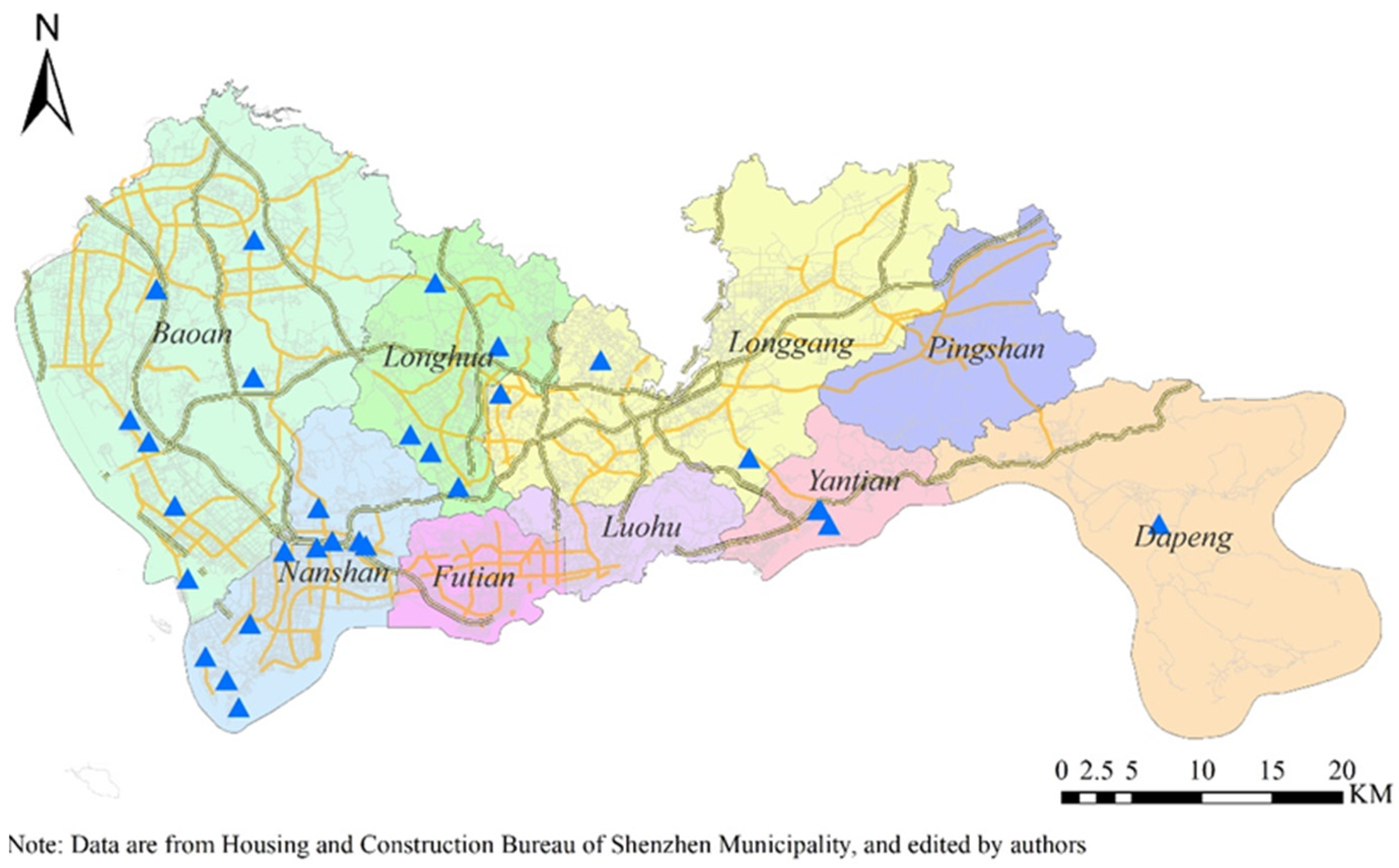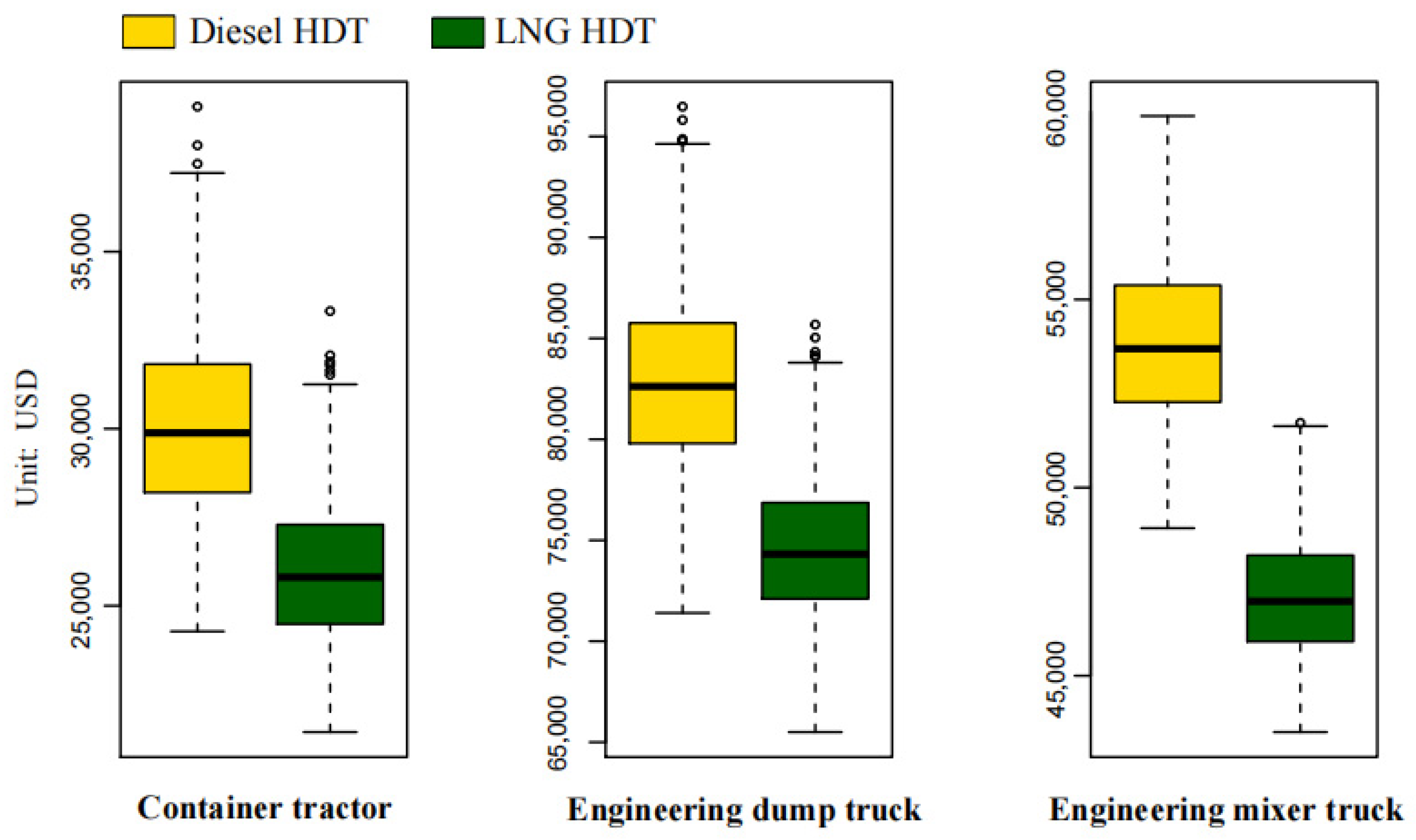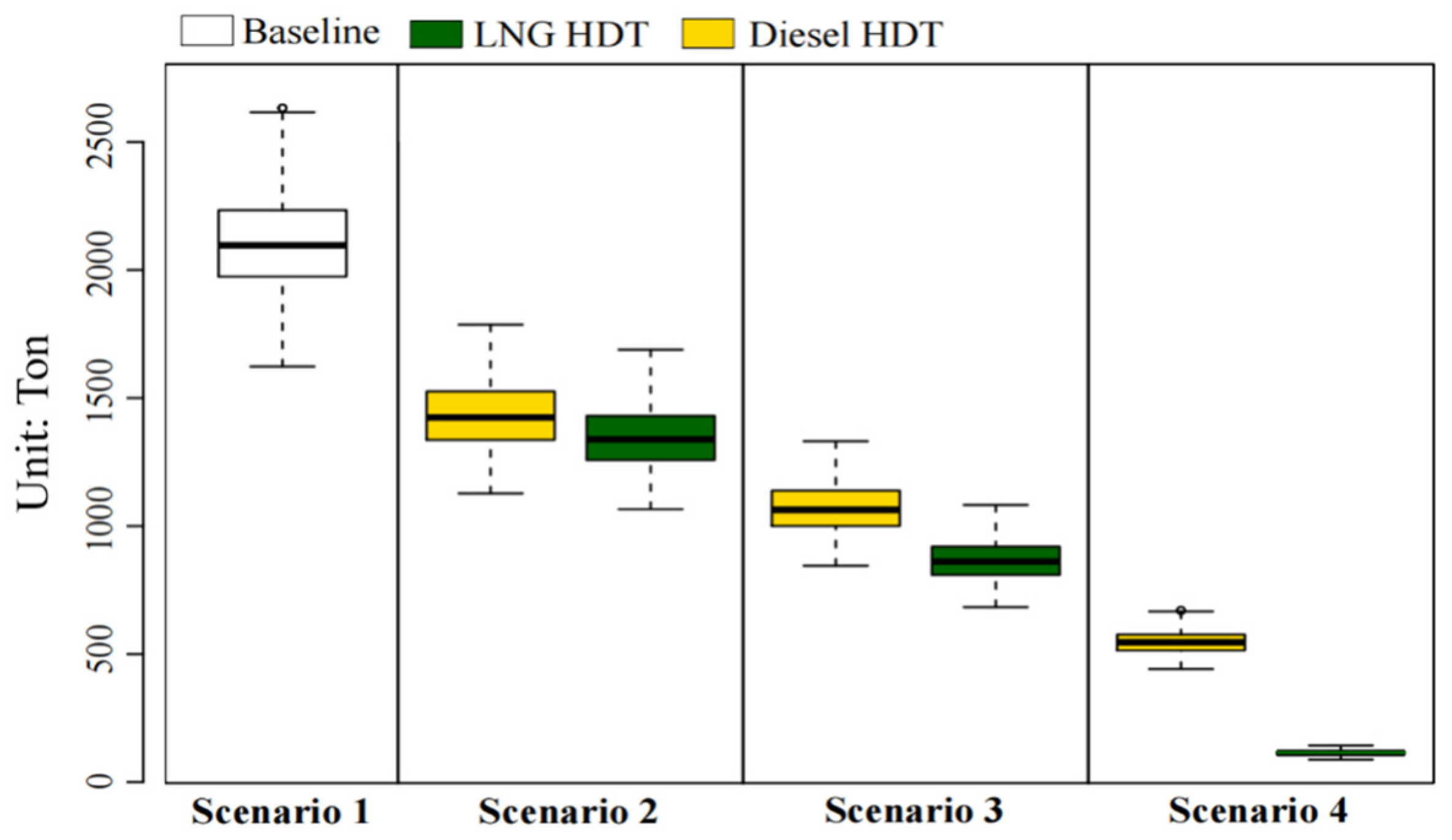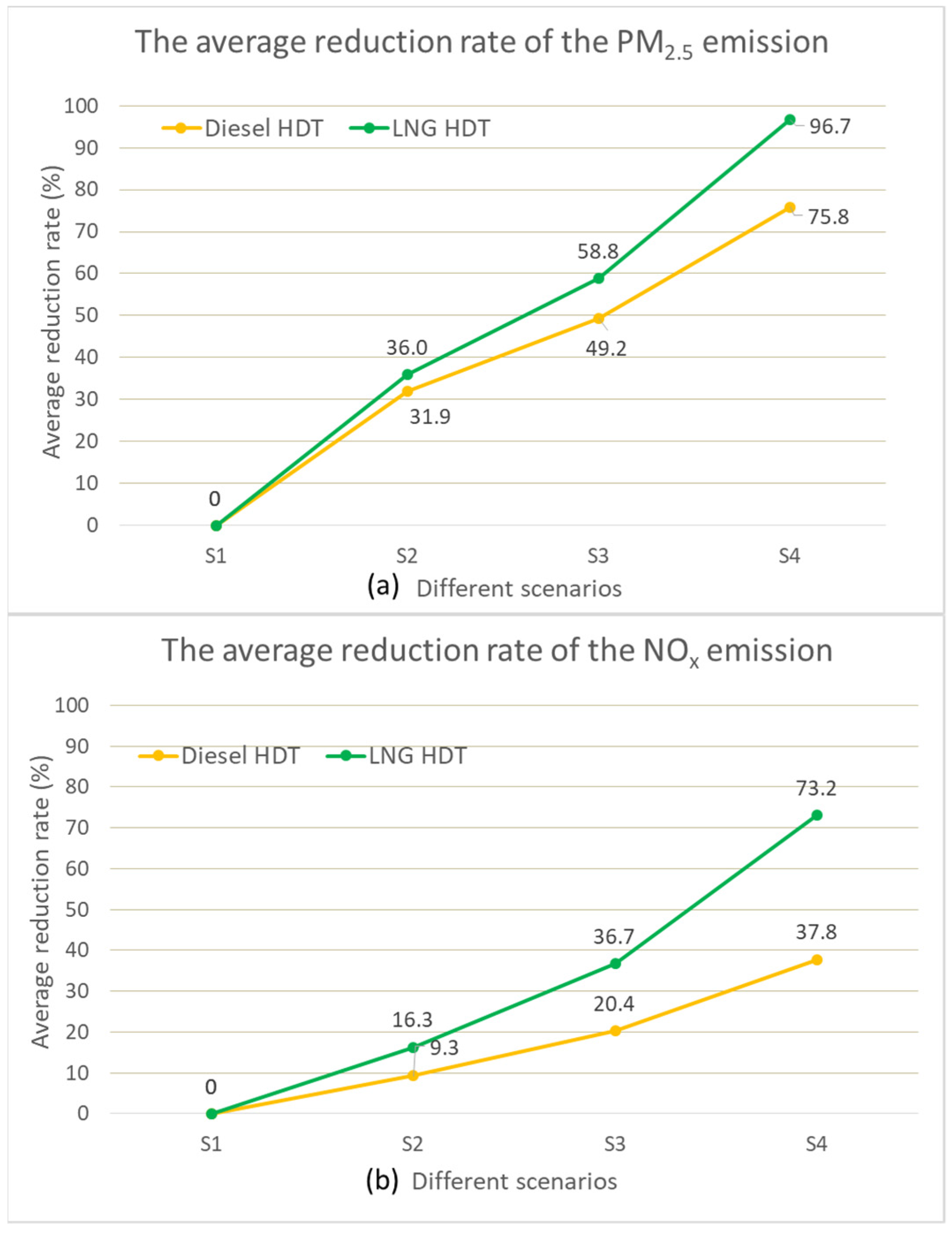Characterizing the Economic and Environmental Benefits of LNG Heavy-Duty Trucks: A Case Study in Shenzhen, China
Abstract
:1. Introduction
2. Application of LNG HDTs in Shenzhen
2.1. The HDTs in Shenzhen
2.2. LNG Supply Security
2.3. LNG Fueling Stations
3. Methodology
3.1. Economic Analysis Methods
- (1)
- Container tractors & engineering dump trucks
- (2)
- Engineering mixer trucks
3.2. Environmental Analysis Methods
3.3. Introduction of MOVES Model and Parameters Settings
3.3.1. Vehicles’ Parameters Settings
3.3.2. The Prices of Fuels
3.3.3. Characteristics of Meteorological Conditions
4. Results and Discussions
4.1. Economic Benefits
4.1.1. Annual Cost Per Vehicle
4.1.2. Cost Tradeoff Evaluation
4.2. Environmental Benefits
4.2.1. PM2.5 Emissions
4.2.2. NOX Emissions
4.3. Discussion
- According to the curves shown in Figure 6a, both diesel HDTs and LNG HDTs can rapidly decrease PM2.5 emissions, which implies that the existing high-pollutant HDT is one of the main contributors of total PM2.5 emissions. Compared to diesel HDT, LNG HDT performs better in PM2.5 emission reduction under different replacement ratios, and achieves a quite high reduction percentage (96.7%) when totally substituting existing HDTs. The reduction rules can benefit policy-makers to meet several kinds of requirements for arranging vehicle control and replacement in different zones.
- From Figure 6b, LNG HDT replacement can significantly reduce NOX emissions, while diesel HDT replacement has a relatively slight effect on the reduction. In Scenario 4, LNG HDTs showed a sharp reduction rate of 73.2%, but diesel HDTs reached a rate of just 37.8%, indicating that diesel HDTs are comparatively limited in NOX emission reduction. In this kind of situation, LNG HDTs are a better alternative.
5. Conclusions and Recommendation
Author Contributions
Funding
Institutional Review Board Statement
Informed Consent Statement
Data Availability Statement
Conflicts of Interest
Appendix A
| Vehicle Type | Fuel Type | Brand | Model Number | Purchase Cost | Horsepower | Drive Type |
|---|---|---|---|---|---|---|
| Container tractor | LNG | C&C TRUCKS | SQR4181N5Z | $47,270 | 260 hp | 4 × 2 |
| Diesel | Dongfeng | EQ4160GLN | $32,021 | 260 hp | 4 × 2 | |
| Engineering dump truck | LNG | C&C TRUCKS | SQR3252N6T4 | $65,568 | 290 hp | 6 × 4 |
| Diesel | Dongfeng | DFL3250AW | $53,369 | 290 hp | 6 × 4 | |
| Engineering mixer | LNG | CIMC | ZJV5254GJBSZ01 | $75,937 | 340 hp | 6 × 4 |
| Diesel | CIMC | ZJV5254GJBSZ01 | $66,788 | 340 hp | 6 × 4 |
| Vehicle Type | Use Intensity (Min, Likeliest, Max) | Fuel Consumption Rate | Lifetime | Maintain Cost |
|---|---|---|---|---|
| Container tractor | (7000, 8000, 9000) km/month | LNG: 0.247 kg/km; Diesel: 0.30 L/km | 10 years | LNG: 3202 USD/year; Diesel: 3586 USD/year |
| Engineering dump truck | (9000, 10,000, 11,000) km/month | LNG: 0.5 kg/km; Diesel: 0.6 L/km | 5 years | LNG: 3050 USD/year; Diesel: 2745 USD/year |
| Engineering mixer | (330, 355, 365) day/year | LNG: 90 kg/day; Diesel: 118 L/day | 3 years | LNG: 5855 USD/year; Diesel: 4757 USD/year |
| Meteorological Conditions | January | February | March | April | May | June | July | August | September | October | November | December |
|---|---|---|---|---|---|---|---|---|---|---|---|---|
| Avg. temperature (°C) | 16.3 | 17.7 | 20.2 | 23.3 | 27.2 | 29.5 | 29.1 | 29.1 | 28.2 | 25.7 | 23.6 | 17.4 |
| Avg. humidity (%) | 63 | 70 | 78 | 72 | 80 | 77 | 74 | 73 | 71 | 68 | 68 | 69 |

References
- Westerdahl, D.; Wang, X.; Pan, X.; Zhang, K.M. Characterization of on-road vehicle emission factors and microenvironmental air quality in Beijing, China. Atmos. Environ. 2009, 43, 697–705. [Google Scholar] [CrossRef]
- Ministry of Ecology and Environment of the People’s Republic of China. China Mobile Source Environmental Management Annual Report 2020. 2021. Available online: http://www.mee.gov.cn/hjzl/sthjzk/ydyhjgl/202109/t20210910_920787.shtml (accessed on 6 December 2021).
- Ahmed, Z.; Ali, S.; Saud, S.; Shahzad, S.J.H. Transport CO2 emissions, drivers, and mitigation: An empirical investigation in India. Air Qual. Atmos. Heal. 2020, 13, 1367–1374. [Google Scholar] [CrossRef]
- Ramacher, M.O.P.; Matthias, V.; Aulinger, A.; Quante, M.; Bieser, J.; Karl, M. Contributions of traffic and shipping emissions to city-scale NOx and PM2.5 exposure in Hamburg. Atmos. Environ. 2020, 237, 117674. [Google Scholar] [CrossRef]
- Kholod, N.; Evans, M.; Gusev, E.; Yu, S.; Malyshev, V.; Tretyakova, S.; Barinov, A. A methodology for calculating transport emissions in cities with limited traffic data: Case study of diesel particulates and black carbon emissions in Murmansk. Sci. Total. Environ. 2016, 547, 305–313. [Google Scholar] [CrossRef] [Green Version]
- Tischer, V.; Fountas, G.; Polette, M.; Rye, T. Environmental and economic assessment of traffic-related air pollution using aggregate spatial information: A case study of Balneário Camboriú, Brazil. J. Transp. Heal. 2019, 14, 100592. [Google Scholar] [CrossRef]
- Dasgupta, S.; Lall, S.; Wheeler, D. Spatiotemporal analysis of traffic congestion, air pollution, and exposure vulnerability in Tanzania. Sci. Total. Environ. 2021, 778, 147114. [Google Scholar] [CrossRef] [PubMed]
- D’Angiola, A.; Dawidowski, L.E.; Gómez, D.R.; Osses, M. On-road traffic emissions in a megacity. Atmos. Environ. 2010, 44, 483–493. [Google Scholar] [CrossRef]
- Zhang, S.; Wu, Y.; Hu, J.; Huang, R.; Zhou, Y.; Bao, X.; Fu, L.; Hao, J. Can Euro V heavy-duty diesel engines, diesel hybrid and alternative fuel technologies mitigate NO X emissions? New evidence from on-road tests of buses in China. Appl. Energy 2014, 132, 118–126. [Google Scholar] [CrossRef]
- Wang, T.; Quiros, D.C.; Thiruvengadam, A.; Pradhan, S.; Hu, S.; Huai, T.; Lee, E.S.; Zhu, Y. Total Particle Number Emissions from Modern Diesel, Natural Gas, and Hybrid Heavy-Duty Vehicles During On-Road Operation. Environ. Sci. Technol. 2017, 51, 6990–6998. [Google Scholar] [CrossRef] [PubMed]
- Huang, X.; Yun, H.; Gong, Z.; Li, X.; He, L.; Zhang, Y.; Hu, M. Source apportionment and secondary organic aerosol estimation of PM2.5 in an urban atmosphere in China. Sci. China Earth Sci. 2013, 57, 1352–1362. [Google Scholar] [CrossRef]
- Wei, L.; Geng, P. A review on natural gas/diesel dual fuel combustion, emissions and performance. Fuel Process. Technol. 2016, 142, 264–278. [Google Scholar] [CrossRef]
- Arteconi, A.; Polonara, F. LNG as vehicle fuel and the problem of supply: The Italian case study. Energy Policy 2013, 62, 503–512. [Google Scholar] [CrossRef]
- Ellingsen, L.A.-W.; Singh, B.; Strømman, A.H. The size and range effect: Lifecycle greenhouse gas emissions of electric vehicles. Environ. Res. Lett. 2016, 11, 054010. [Google Scholar] [CrossRef]
- Wolfram, P.; Wiedmann, T. Electrifying Australian transport: Hybrid life cycle analysis of a transition to electric light-duty vehicles and renewable electricity. Appl. Energy 2017, 206, 531–540. [Google Scholar] [CrossRef] [Green Version]
- National Bureau of Statistic of China. China Statistical Yearbook 2020. 2021. Available online: https://www.stats.gov.cn/tjsj/zxfb/202102/t20210227_1814154.html (accessed on 6 December 2021).
- Bureau of Statistics of Shenzhen Municipality, Statistical Bulletin of National Economic and Social Statistical Bulletin of National Economic and Social Development of Shenzhen in 2020. 2021. Available online: https://tjj.sz.gov.cn/nj2020/nianjian.html?2020 (accessed on 6 December 2021).
- The Shenzhen Municipal People’s Government. Shenzhen Atmospheric Environmental Quality Improvement Plan (2017–2020). 2017. Available online: https://www.sz.gov.cn/zfgb/2017/gb995/content/post_4995986.html (accessed on 6 December 2021).
- Development and Reform Commission of Shenzhen Municipality. Guidelines for Application of Subsidy Funds for Promoting the Use of LNG Freight Vehicles in Shenzhen Road Freight Industry in 2015. In 2015. Available online: https://fgw.sz.gov.cn/zwgk/qt/tzgg/content/post_4599242.html (accessed on 6 December 2021).
- Askin, A.C.; Barter, G.; West, T.H.; Manley, D.K. The heavy-duty vehicle future in the United States: A parametric analysis of technology and policy tradeoffs. Energy Policy 2015, 81, 1–13. [Google Scholar] [CrossRef] [Green Version]
- Karavalakis, G.; Hajbabaei, M.; Jiang, Y.; Yang, J.; Johnson, K.C.; Cocker, D.R.; Durbin, T.D. Regulated, greenhouse gas, and particulate emissions from lean-burn and stoichiometric natural gas heavy-duty vehicles on different fuel compositions. Fuel 2016, 175, 146–156. [Google Scholar] [CrossRef] [Green Version]
- Guo, J.; Ge, Y.; Hao, L.; Tan, J.; Li, J.; Feng, X. On-road measurement of regulated pollutants from diesel and CNG buses with urea selective catalytic reduction systems. Atmos. Environ. 2014, 99, 1–9. [Google Scholar] [CrossRef]
- Zhang, S.; Wu, Y.; Liu, H.; Huang, R.; Yang, L.; Li, Z.; Fu, L.; Hao, J. Real-world fuel consumption and CO2 emissions of urban public buses in Beijing. Appl. Energy 2014, 113, 1645–1655. [Google Scholar] [CrossRef]
- Kumar, S.; Kwon, H.-T.; Choi, K.-H.; Lim, W.; Cho, J.H.; Tak, K.; Moon, I. LNG: An eco-friendly cryogenic fuel for sustainable development. Appl. Energy 2011, 88, 4264–4273. [Google Scholar] [CrossRef]
- Federal Transit Administration. National Transit Database. In 2016; Volume 2016. Available online: https://www.transit.dot.gov/sites/fta.dot.gov/files/docs/ntd/66011/2016-ntst.pdf (accessed on 1 December 2021).
- Dickens, M.; Neff, J.; Grisby, D. APTA 2016 Public Transportation Fact Book. In Environmental Protection: 2017. Available online: https://www.apta.com/wp-content/uploads/Resources/resources/statistics/Documents/FactBook/2016-APTA-Fact-Book.pdf (accessed on 1 December 2021).
- Li, Y.L.; Lv, J.X.; Li, X.Y. Comparison and Selection of Low-carbon Transportation Vehicles in the Context of Carbon Neutrality. Transp. Energy Conserv. Environ. Prot. 2021, 17, 1–8. [Google Scholar]
- Hou, X.J.; Xiong, N.; Wang, Y.H.; Liu, Z.E. articulate Matter Emission Characteristic of Gasoline/Compressed Natural Gas Dual-Fuel Engine. Chin. Intern. Combusion Engine Eng. 2021, 42, 74–80. [Google Scholar]
- Yao, M.F.; Yan, B.W.; Zheng, Z.Q.; Qin, Y.F. The development and application of combustion technologies for spark ignition heavy-duty natural gas engines. Nat. Gas Ind. 2017, 37, 79–86. [Google Scholar]
- Yoon, S.; Collins, J.; Thiruvengadam, A.; Gautam, M.; Herner, J.; Ayala, A. Criteria pollutant and greenhouse gas emissions from CNG transit buses equipped with three-way catalysts compared to lean-burn engines and oxidation catalyst technologies. J. Air Waste Manag. Assoc. 2013, 63, 926–933. [Google Scholar] [CrossRef] [Green Version]
- Yoon, S.; Hu, S.; Kado, N.Y.; Thiruvengadam, A.; Collins, J.F.; Gautam, M.; Herner, J.D.; Ayala, A. Chemical and toxicological properties of emissions from CNG transit buses equipped with three-way catalysts compared to lean-burn engines and oxidation catalyst technologies. Atmos. Environ. 2014, 83, 220–228. [Google Scholar] [CrossRef]
- Kwon, S.I.; Hong, J.H. Particle number and size distribution characteristics from diesel- and liquefied-natural-gas-fuelled buses for various emission certification modes in the Republic of Korea. Proc. Inst. Mech. Eng. Part D J. Automob. Eng. 2010, 224, 1569–1579. [Google Scholar] [CrossRef]
- Tong, F.; Jaramillo, P.; Azevedo, I.M.L. Comparison of Life Cycle Greenhouse Gases from Natural Gas Pathways for Medium and Heavy-Duty Vehicles. Environ. Sci. Technol. 2015, 49, 7123–7133. [Google Scholar] [CrossRef] [Green Version]
- Song, H.; Ou, X.; Yuan, J.; Yu, M.; Wang, C. Energy consumption and greenhouse gas emissions of diesel/LNG heavy-duty vehicle fleets in China based on a bottom-up model analysis. Energy 2017, 140, 966–978. [Google Scholar] [CrossRef]
- Graham, L.A.; Rideout, G.; Rosenblatt, D.; Hendren, J. Greenhouse gas emissions from heavy-duty vehicles. Atmos. Environ. 2008, 42, 4665–4681. [Google Scholar] [CrossRef]
- Osorio-Tejada, J.L.; Llera-Sastresa, E.; Scarpellini, S. A multi-criteria sustainability assessment for biodiesel and liquefied natural gas as alternative fuels in transport systems. J. Nat. Gas Sci. Eng. 2017, 42, 169–186. [Google Scholar] [CrossRef] [Green Version]
- Transport Commission of Shenzhen Municipality. The Fourteenth Five-Year Comprehensive Urban Traffic Planning of Shenzhen. 2021. Available online: https://www.seetao.com/details/62096.html (accessed on 1 December 2021).
- Development and Reform Bureau of Yantian District. Special Fund for LNG Container Traitors and LNG Fueling Station in Yantian. 2017. Available online: http://www.yantian.gov.cn/ytfzhggj/gkmlpt/content/5/5912/post_5912565.html#17391 (accessed on 6 December 2021).
- Hao, H.; Liu, Z.; Zhao, F.; Li, W. Natural gas as vehicle fuel in China: A review. Renew. Sustain. Energy Rev. 2016, 62, 521–533. [Google Scholar] [CrossRef]
- Housing and Construction Bureau of Shenzhen Municipality. LNG Fueling Station. 2017. Available online: http://zjj.sz.gov.cn/ztfw/rqjg/qcjqz2017/index.html (accessed on 6 December 2021).
- China National Offshore Oil Corporation Shenzhen Gas Co., L. Provide Clean Energy, Construct Low-carbon Shenzhen. 2018. Available online: https://www.cnoocltd.com/module/download/down.jsp?i_ID=15294594&colID=3881 (accessed on 6 December 2021).
- Fan, Y.; Parker, N.; Scheitrum, D.; Dominguez-Faus, R.; Jaffe, A.M.; Medlock, I.K.; Lee, A. Geospatial, Temporal and Economic Analysis of Alternative Fuel Infrastructure: The case of freight and U.S. natural gas markets. Energy J. 2017, 38, 199–230. [Google Scholar] [CrossRef]
- Hu, M.; Cai, J.; Huang, W.; Chen, J. The evaluation on liquefied natural gas truck promotion in Shenzhen freight. Adv. Mech. Eng. 2017, 9, 2071939594. [Google Scholar] [CrossRef] [Green Version]
- Beijing Sustainability and Development Center, Tsinghua University. Strategy for the Alternative Fuel Vehicles in Beijing. 2012. Available online: https://www.efchina.org/Attachments/Report/reports-efchina-20121122-zh/%E5%8C%97%E4%BA%AC%E5%B8%82%E6%9B%BF%E4%BB%A3%E7%87%83%E6%96%99%E8%BD%A6%E5%8F%91%E5%B1%95%E6%88%98%E7%95%A5%E7%A0%94%E7%A9%B6.pdf (accessed on 6 December 2021).
- Zheng, B.; Huo, H.; Zhang, Q.; Yao, Z.L.; Wang, X.T.; Yang, X.F.; Liu, H.; He, K.B. High-resolution mapping of vehicle emissions in China in 2008. Atmos. Chem. Phys. Discuss. 2014, 14, 9787–9805. [Google Scholar] [CrossRef] [Green Version]
- Guevara, M.; Tena, C.; Soret, A.; Serradell, K.; Guzmán, D.; Retama, A.; Camacho, P.; Jaimes-Palomera, M.; Mediavilla, A. An emission processing system for air quality modelling in the Mexico City metropolitan area: Evaluation and comparison of the MOBILE6.2-Mexico and MOVES-Mexico traffic emissions. Sci. Total. Environ. 2017, 584-585, 882–900. [Google Scholar] [CrossRef]
- Chen, S.; Du, Z.; Shi, X.; Liu, Y.; Li, S.; Shao, C.; Steve-Harold, K.W. MOVES-Beijing-based high spatial and temporal resolution ammonia emissions from road traffic in Beijing. Atmos. Environ. 2021, 256, 118443. [Google Scholar] [CrossRef]
- The Shenzhen Municipal People’s Government. Shenzhen atmospheric environmental quality improvement plan (2013–2016). 2013. Available online: http://www.sz.gov.cn/zfgb/2013/gb852/content/post_4952084.html (accessed on 6 December 2021).






| Type | Container Truck | Engineering Dump Truck | Engineering Mixer Truck | Others | |
|---|---|---|---|---|---|
| Internal | Long-Haul | ||||
 |  |  |  |  | |
| Main applications | Transportation of goods in port | Transportation of goods for a long distance | Transportation of sand, soil, etc., with a large open container that can pour goods onto the ground | Transportation of concrete, with a mixer tank | Logistics |
| Penetration of all HDTs (%) | 1% | 37% | 5% | 6% | 51% |
| LNG HDT performance | Good | Modest | Modest | Modest | - |
| Scenarios | Plan | Introduction | Emissions in High-Temperature Season | Emissions in Low-Temperature Season | Annual Emissions | Annual Reduction | Avg. Reduction Rate |
|---|---|---|---|---|---|---|---|
| S1 | - | Maintaining the status quo | 895 t | 1210 t | 2106 t | - | - |
| S2 | A | Promoting 15,000 China-V diesel HDTs | 609 t | 824 t | 1434 t | 672 t | 31.9% |
| B | Promoting 15,000 LNG HDTs | 573 t | 774 t | 1345 t | 761 t | 36.0% | |
| S3 | A | Promoting 35,000 China-V diesel HDTs | 455 t | 615 t | 1070 t | 1036 t | 49.2% |
| B | Promoting 35,000 LNG HDTs | 368 t | 498 t | 866 t | 1240 t | 58.8% | |
| S4 | A | Promoting 76,000 China-V diesel HDTs | 217 t | 293 t | 510 t | 1596 t | 75.8% |
| B | Promoting 76,000 LNG HDTs | 30 t | 40 t | 70 t | 2036 t | 96.7% |
| Scenarios | Plan | Introduction | Emissions in High-Temperature Season | Emissions in Low-Temperature Season | Annual Emissions | Annual Reduction | Avg. Reduction Rate |
|---|---|---|---|---|---|---|---|
| S1 | - | Maintaining the status quo | 32,669 t | 30,344 t | 63,013 t | - | - |
| S2 | A | Promoting 15,000 China-V diesel HDTs | 29,627 t | 27,518 t | 57,133 t | 5880 t | 9.3% |
| B | Promoting 15,000 LNG HDTs | 27,352 t | 25,406 t | 52,747 t | 10,266 t | 16.3% | |
| S3 | A | Promoting 35,000 China-V diesel HDTs | 25,996 t | 24,146 t | 50,078 t | 12,935 t | 20.4% |
| B | Promoting 35,000 LNG HDTs | 20,689 t | 19,218 t | 39,894 t | 23,119 t | 36.7% | |
| S4 | A | Promoting 76,000 China-V diesel HDTs | 20,309 t | 18,864 t | 39,103 t | 23,910 t | 37.8% |
| B | Promoting 76,000 LNG HDTs | 8763 t | 8140 t | 16,903 t | 46,110 t | 73.2% |
Publisher’s Note: MDPI stays neutral with regard to jurisdictional claims in published maps and institutional affiliations. |
© 2021 by the authors. Licensee MDPI, Basel, Switzerland. This article is an open access article distributed under the terms and conditions of the Creative Commons Attribution (CC BY) license (https://creativecommons.org/licenses/by/4.0/).
Share and Cite
Zhao, Q.; Huang, W.; Hu, M.; Xu, X.; Wu, W. Characterizing the Economic and Environmental Benefits of LNG Heavy-Duty Trucks: A Case Study in Shenzhen, China. Sustainability 2021, 13, 13522. https://doi.org/10.3390/su132413522
Zhao Q, Huang W, Hu M, Xu X, Wu W. Characterizing the Economic and Environmental Benefits of LNG Heavy-Duty Trucks: A Case Study in Shenzhen, China. Sustainability. 2021; 13(24):13522. https://doi.org/10.3390/su132413522
Chicago/Turabian StyleZhao, Qian, Wenke Huang, Mingwei Hu, Xiaoxiao Xu, and Wenlin Wu. 2021. "Characterizing the Economic and Environmental Benefits of LNG Heavy-Duty Trucks: A Case Study in Shenzhen, China" Sustainability 13, no. 24: 13522. https://doi.org/10.3390/su132413522
APA StyleZhao, Q., Huang, W., Hu, M., Xu, X., & Wu, W. (2021). Characterizing the Economic and Environmental Benefits of LNG Heavy-Duty Trucks: A Case Study in Shenzhen, China. Sustainability, 13(24), 13522. https://doi.org/10.3390/su132413522






